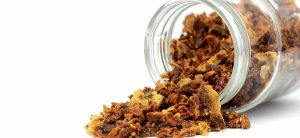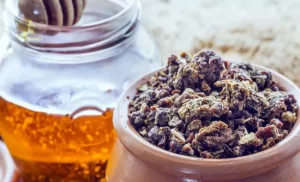WHAT IS POLEN AND HOW IS IT CONSUMED?
17/03/2022HOW SHOULD PROPOLIS BE CONSUMED?
23/08/2022propolis; It is also known as preboli or bee gum among beekeepers. The word propolis is formed by the combination of the words Pro (pre, before) and Polis (city) in the Ancient Greek language. The first use of the word, which is also known as Propolis in English, dates back to the 15th century as far as is known.
The resinous substances collected by bees from the leaves, stems and buds of plants are called propolis. It is a product used by bees to sterilize the honeycombs in the hive, to protect the hive against external dangers, to repair and strengthen the honeycombs. In order to produce raw propolis, bees biochemically change the substances they obtain from the stems, leaves, buds and nectars of many plants, especially coniferous trees, with their own secretions. Bees first cover their cells with propolis and then the queen lays her eggs in the cells. In addition, bees put honey, pollen and royal jelly in the honeycomb eyes plastered with propolis. Thus, the products of the bee are kept intact in the hive. Although the color of propolis varies, it is generally a transition from light brown to dark brown. It is brittle and hard in cold and sticky in heat. Due to its sticky feature, it interacts with fat and proteins on the skin. In general, it contains 30% wax, 50% resin and herbal balm, 10% essential and aromatic oils, 5% pollen and other substances in its natural structure. More than 300 components have been identified in propolis and its composition varies according to the plant source and local flora.

Propolisin protein, karbonhidrat, lipid, vitamin-mineral içeriği oldukça düşüktür. Bu nedenle besinsel bir destek olarak düşünülmesi zordur. Propolisin faydalı biyolojik özellikleri daha çok flavonoidler ve hidroksisinnamik asit türevleri gibi fenolik maddelere atfedilmektedir. Propoliste bulunan en önemli bileşik grubu olarak flavonoidler görülmektedir. Flavonoidler fotosentez yapan hücrelerde bulunurlar. Sekonder bitki metabolitleri olarak bulundukları için insanlar tarafından sentezlenemezler ve bu nedenle insan beslenmesi için önemlidirler.
Propolis genellikle koyu kahverengi bir kütle olmasına rağmen rengi elde edildiği kaynaklara göre değişkenlik gösterir. Karakteristik bir kokuya sahip olan propolisin, içeriği de oldukça zengindir. Daha önce de bahsettiğimiz gibi arılar propolis yaparken bitki özlerini kullandıkları için bileşimleri kovanın etrafındaki bitki örtüsüne, iklim koşullarına, coğrafi bölgeye göre değişkenlik gösterir.
- Oldukça zengin bir içeriği olan Ham Propolis, hücrelerin yenilenme sürecini hızlandırarak yaraların iyileşmesini kolaylaştırır.
- Ham Propoliste bulunan güçlü bir antioksidandan dolayı, cilt sağlığı üzerinde oldukça iyi etkileri vardır. Cildin yenilenmesini ve diri olmasını sağlar.
- Ham Propolis Mmkrop ve bakterilere karşı koruma kalkanı oluşturur. Arı kovanını mikroplardan arındırdığı gibi, insan vücudunda da mikrop ve bakteri oluşumuna engel olur, hastalıklara yakalanma tehlikesinin düşürür.
- Uçuk ve ağız yaralarını iyileştirir. Ağız kenarında oluşan yaralar başta olmak üzere, çeşitli bölgelerde oluşan uçukların tedavisinde kullanılır.
- Propolis bağışıklık sistemini güçlendirir. Güçlü içeriği ile bağışıklık sisteminin düzenli ve sağlıklı olmasını sağlar.
Yüksek oranda fenolik ve flavonoid maddeler içeren propolis yüzyıllardır olduğu gibi halen, arılar için hayati önem taşımaktadır. Propolis, saf haliyle günümüzde hem yetişkinler hem de çocuklar tarafından gıda ve takviye edici gıda formüllerinde ve kozmetik ürünlerde pek çok farklı şekilde kullanılmaktadır.





